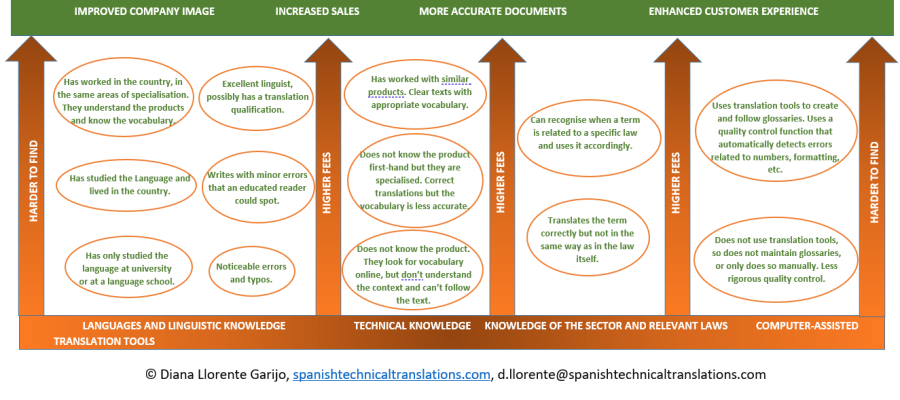If you needed a technical translator, would you know where to look? And what to look for? Or how their profile may influence their translations? In this article, I answer these questions and give you an overview of the different translator profiles.
The article is quite long, so I’ve included a list of contents with direct links to the various sections.
INTRODUCTION
Technical translation is one of the most difficult specialities, since it requires a perfect command of the language and an excellent understanding of the technology – a combination of skills from both the Arts and the Sciences.
This may explain why it is hard to find good professionals. For example, one of my clients said that he didn’t trust “conventional” translators, because one he had previously contracted didn’t understand his products, so he ended up translating the texts himself.
This caused him two problems: 1) he spent a lot of time on translating that would have been better spent running his business; and 2) he translated into English, which was not his native language, so the text sounded ‘odd’ (one of his slogans even had negative connotations). Clearly, this wasn’t the best use of his time, nor the best way to create a good impression of his company. In this article you can read more about the advantages and disadvantages of doing translations in-house as opposed to contracting a professional translator.
There are some excellent technical translators out there who you can entrust your translations to and who will deliver quality work, but you need to know where to find them and what to look for.
Below I outline four aspects that, in my opinion, influence the quality of technical translations.
But first of all, what do we mean by a “quality translation”?
WHAT IS A GOOD TRANSLATION?
In the case of technical translations, I believe that a quality translation has the following characteristics:
- The original meaning has been maintained
- The translated text is clear, with no ambiguities
- It is easy to read and understand
- The language used is natural for the reader and gives a good impression of the product and company.
And what is it that differentiates a good technical translator, who creates these quality translations, from another professional who is perhaps equally good but who works in a different field?
I’ll explain this below.
CHARACTERISTICS OF A GOOD TECHNICAL TRANSLATOR
The profession of translator is not regulated, so you’ll come across a huge variety of profiles. Some translators have lived abroad for several years. Some have a degree in translation while others do not, but have an in-depth knowledge of their field (e.g., some doctors also translate medical books).
So, what are the main differences between translators? And, more importantly, what do you need? Would you prefer to contract a doctor to translate your medical book or an academically-qualified translator who, if you need to update your manual in the future, has the tools to ensure the consistency of the vocabulary?
Let’s take a look. In my opinion, the following are the four main aspects that differentiate one technical translator from another:
- Knowledge of languages: This means speaking the language and understanding it perfectly, with all its nuances, being up to date with changes in spelling rules and knowing the grammar inside out.
- Technical knowledge and experience: Does the translator understand your products? For example, if they are translating a user manual for an oscilloscope, do they themselves understand the instructions for use?
- Knowledge of the sector and the corresponding regulations: It is not only about knowing the product. Will the translator be able to detect whether there is an existing official translation of a law or technical regulation, in which case they will need to use the same vocabulary?
- Use of computer-assisted translation tools: Will the translator remember all past translations of your products that you have already approved? And, if you change a number by mistake, will they spot it?
If you’d like to see these four aspects represented in an infographic, click here. But continue reading if you want to read a brief explanation of each one.
Alternatively, you can watch a video in which I explain what is required to be a good technical translator (at minutes 4:30 and 17:10).
1. KNOWLEDGE OF LANGUAGES
- The first and most fundamental requirement is that the translator is a native speaker of the language to translate into. Because, regardless of how well someone writes in a foreign language, there will always be something that sounds odd in the translated text.
I think the only exception to this is if you can’t find anyone specialised in a topic and the text is not intended for publication – for example, my native language is Spanish but a client once asked me to translate the specifications for a customised software program into English. If a translation is intended for publication, however, whether in print or online, it should always be reviewed by a native speaker.
- The translator should be up to date on the spelling rules and grammar for their language. In my case, I consult official resources such as the Real Academia Española (RAE) and Fundación del Español Urgente (Fundéu), as well as the specialised guides of different organisations.
- The translator should also be good at writing the type of documents that the client needs translated.
- With regard to the source language (that being translated from), not all translators master it to the same level. Some will have studied the language at university or at a language school, with short stays abroad. But is this enough? Usually not, since they are unlikely to be familiar with the nuances, local idioms and specialised vocabulary. A good translator will generally have lived for at least a year or two in a country where the language is spoken, and will have integrated into the community (studying or working with locals).
- Some translators work from more than one language, but do not master them all equally. They are usually only truly specialised in one or two of these, or three at the most.
- Finally, even if they speak the language perfectly, understand all its nuances, and are up to date on spelling and grammatical changes, they also need to know how to translate (and that doesn’t mean translating word for word, but rather conveying the idea and the message). For this reason, you may get better results contracting someone with a translation degree, or at least with significant experience in translation. In my case, my first university degree was in Physical Sciences, but I also have a Master’s in Technical Translation. To find out more about my experience, click here, or take a look at my LinkedIn profile.
In the diagram below, I have summarised these aspects regarding knowledge of languages.
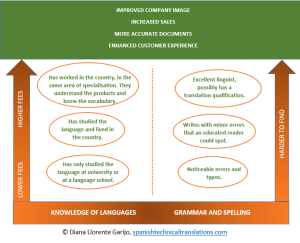
A translator should be a native speaker of the language they translate to, and ideally have lived a couple of years in a country in which the language they translate from is spoken.
2. TECHNICAL KNOWLEDGE AND EXPERIENCE
Qualifications or experience? This is a topic that stirs up a lot of debate among translators.
Some say it is more important that a translator has a degree in translation, that they wouldn’t be qualified to do the work otherwise, while others place more importance on a translator’s previous experience in the relevant sector.
There is a high percentage of translators who fall into one category or another (technical experience vs. academic qualifications), so you’re likely to come across both types of professionals.
I think that in most fields of translation, and certainly in technical translation, it is extremely important that the translator understands the text. If they don’t, they will not be able to convey its meaning in another language. (When I review translations, I can immediately see whether or not the translator understands the text. I once read a translated report about nuclear energy and I didn’t understand a thing, but when I looked at the original text I understood it perfectly. This is because the meaning and clarity of the message was lost in the translation).
But I’ve also seen the opposite situation – translators with an engineering background who are technically excellent, able to find the exact words for a highly complex article, but who make minor grammatical mistakes.
So which is better?
(If you prefer listening to reading, at minute 17:10 in this video about technical translation, I briefly explain the importance of technical knowledge).
These are the four profile types in terms of technical experience:
- Not specialised in the technical sector.
- Has a translation degree, no technical experience but highly specialised → Carefully written texts, although the vocabulary is perhaps too generic.
- Has technical experience and has a perfect understanding of the texts → The translation maintains the meaning perfectly, though there may be some minor typing errors.
- Has technical experience and translator training → Carefully written texts in terms of grammar and language, and the meaning, clarity and sector-specific vocabulary are maintained.
In no circumstances would I recommend choosing a non-specialised translator for a technical text. Regarding profiles 2 and 3, it would depend on how technical the text is and whether you place more importance on the quality of writing or the use of technical vocabulary. Profile 4 combines the advantages of the previous profile types, the only disadvantage being that these translators are more difficult to find and are more expensive.
These profiles are represented in the diagram below.
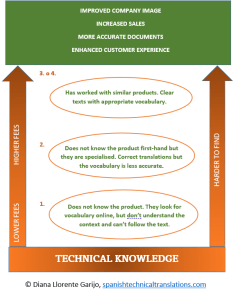
The technical translator must understand the text in order to be able to convey its meaning in another language.
3. KNOWLEDGE OF THE SECTOR AND CORRESPONDING REGULATIONS
In my opinion, it is extremely useful to know the sector from within, in order to:
- Understand the context. This helps in correctly translating any possible minor ambiguities and in choosing the most appropriate vocabulary and expressions. I explain this at minute 4:37 in this video about technical translation.
- Detect whether there is an existing official translation of a specific regulation, in which case the same vocabulary will need to be used. For example, in the case of hazardous chemical substances or dangerous goods, where the specific, official hazard statements and precautionary statements must be respected. Here is a brief example of how this influences the translation process of some data sheets).
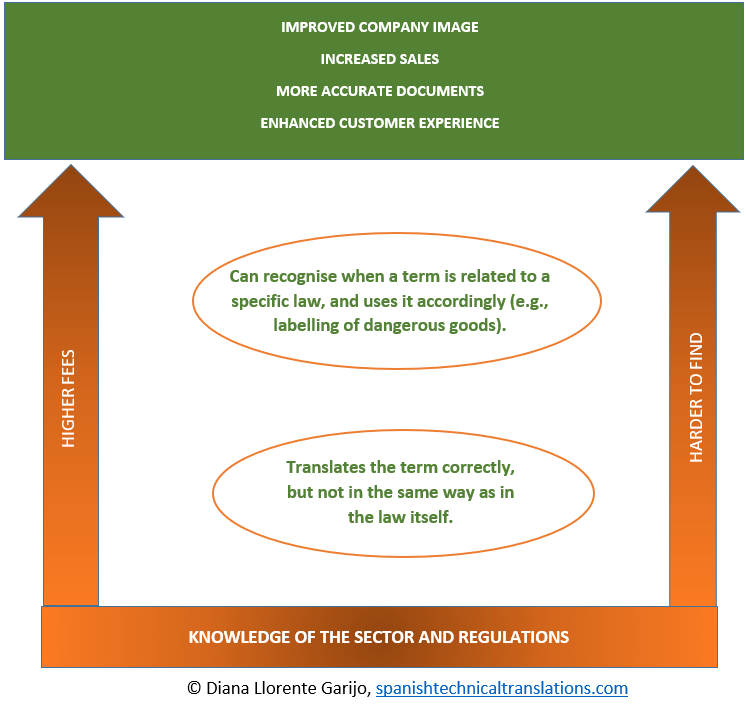
A good technical translator must be familiar with their client’s sector and the corresponding regulations.
4. USE OF COMPUTER-ASSISTED TRANSLATION TOOLS
Translators often use specific tools (known as CAT tools) that help them to maintain glossaries, consult previous translations (their own or those of the client) and, sometimes, to improve efficiency.
It is important to understand that these tools have nothing to do with machine translation.
The main differences between CAT tools and machine translation are that, with CAT tools, previous translations done by the translator are consulted (not anonymous translations of variable quality on the Internet), and they do not “create” translations automatically, they only show previous, similar translations, and highlight differences between the texts. The translator can then review these previous translations and adapt them if useful.
A CAT tool, among other functions, automatically checks how a specific technical term has been translated in the past, creates glossaries with the terms approved by the client, and performs quality control checks.
To give you an idea, the following image shows the screen of a CAT tool (the text is from a press release and is not confidential).
In the left-hand column is the original text and in the right-hand column the translated text. In the upper left of the screen, I ran a search to see how I had previously translated “vector network analyzer”. In the upper right of the screen, the tool displays the translation from a glossary I had created previously.
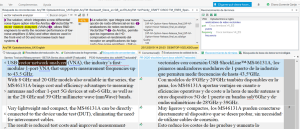
Computer-assisted translation tools help maintain the specific vocabulary used by the client and also perform quality control checks
Advantages of a CAT tool:
- Allows you to always translate words and phrases in the same way, such as the names of products, staff job titles or your company’s slogan.
- Improves the clarity of manuals and instructions. Each piece of equipment mentioned in the document will always have the same name, and in future updates of the document.
- Allows entire paragraphs already approved by the client to be translated in exactly the same way. For example, a short description about your company that appears at the end of all your brochures.
- Helps maintain the original formatting. Its quality control function highlights any changes in formatting, such as bold, italics, etc.
- Checks numbers, dates and spelling and alerts you to any inconsistencies.
- Allows you to translate different types of files, from standard Word and Excel files to files that are compatible with InDesign.
In my opinion, these tools are essential for technical translations, where certain items, products, etc., should always be named in the same way. However, these tools may not be necessary for other types of translation (e.g. literary translation), and a text translated directly in Word may even flow better and sound more natural.
The majority of technical translators use these tools, but they are quite expensive (the licence for my one cost €900). For this reason, a translator who is just starting out may be reluctant to invest in one. Or, if a translator specialises in other fields, it might not make sense to buy one of these tools just to do a technical translation.
And, although these tools are relatively intuitive, there are many functions that the translator needs to be familiar with in order to ensure the quality of the text, which means investing time in learning how to use them properly.
CAT tools have one disadvantage, however: they divide the text into “segments” (usually sentences). And, as sentences are not the same length in all languages (in Spanish we tend to write longer subordinate clauses, for example), the translated text might sometimes sound a bit rigid.
For this reason, I use the following translation method: I always translate using my CAT tool so that I can avail of its quality control functions, create glossaries, etc. If I’m working with a type of text that requires a more natural flow, such as a blog post, brochure or website, I export the final version to Word, check the translation to ensure that it reads well, and make some final style changes.
In the diagram below, I summarise the different profiles of technical translators with regard to CAT tools.
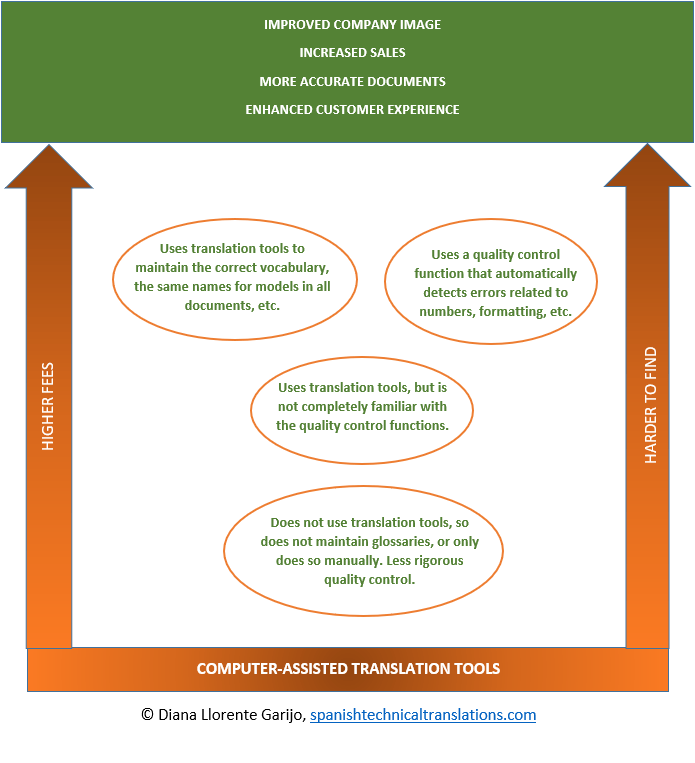
Computer-assisted translation tools help maintain the specific vocabulary used by the client and also perform quality control checks.
WHERE TO FIND A GOOD TECHNICAL TRANSLATOR
Now that I have explained the main characteristics of a good technical translator, we’ll move on to the question of how to find one and how to know whether they meet these characteristics.
- Professional bodies and associations: A good translator will usually have joined a professional association (paying a membership fee). They are also likely to participate in its events, conferences and courses to keep up to date with developments in their field. All associations have a search engine for finding translators working with specific languages and specialising in certain fields.
However, not all associations have the same requirements for membership. Some ask that translators have a translation degree or they require them to do specific tests, while others have no entry requirements whatsoever. Which is why some associations are considered more prestigious than others. In general, having a look at professional associations is one of the best ways to find a professional translator.
If you want to find a good translator for Spanish in Spain, there are various local and national associations. For example, as I live in Barcelona and I’m interested in attending in-person events with other translators, I joined APTIC, the Association of Professional Translators and Interpreters of Catalonia (see my APTIC profile). I am also a member of the Chartered Institute of Linguists in the UK.
I recommend looking in the directories of a professional association in your country, and reading the descriptions of the translators until you find someone who might be suitable for your needs.
- Translator directories: You can also look in translator directories (the most well-known are Proz.com and Translatorscafe.com). Unlike professional associations, however, there are no requirements for inclusion in these directories.
I am a member of Proz.com. I signed up at the beginning of my career because it is a good place to find translation agencies, through whom I have offered courses for other translators.
The main advantage to looking for translators in these directories is that you will find translators in any field and at any price. But this also has its disadvantages; it’s easy to get lost among so many people, with there being no requirements in terms of membership or quality.
- Upwork and similar platforms: These are like the directories in that there are no requirements for joining, and they are not translation-specific. You are unlikely to find professional translators on these platforms, so I definitely wouldn’t recommend them.
- Search engines: Most professional translators have a website, so you could carry out an online search. But you would need to make your search very specific (e.g., “technical translator to Spanish specialised in xxx”), otherwise only translation agencies will be displayed, who have greater capacity to publish and position themselves well.
Here you will find the more marketing-savvy translators who have invested a substantial amount of time in improving their professional image. The advantage of websites is that they contain a lot of information about the translator, so you get a good idea about them and their services. Just make sure, though, that they have more to offer than a good grasp of marketing!
- LinkedIn: This is another good place to find professional translators. As with the websites, you are likely to find the more marketing-savvy translators here. The advantage with LinkedIn is that you have access to more detailed information about the translator’s qualifications and professional career, although finding the right person via your searches is no easy task.
SUMMARY
In my opinion, there are four main aspects that differentiate some translators from others. These are:
- Knowledge of languages
- Technical knowledge and experience
- Knowledge of the sector and corresponding regulations
- Use of computer-assisted translation tools
When you choose the right translator, the translated text will:
- Maintain the original meaning
- Be clear, without any ambiguities in the translation
- Be easy to read and understand
- Use the vocabulary that the client uses, and give a good impression of the company and its products.
Finally, if you’re looking for a quality translator, you can find them in professional associations, via search engines (check that the translator is a member of a professional association), and on LinkedIn.
In the following diagram I summarise the different translator profiles.

There are lots of technical translators! What differentiates them?
I hope you found this article useful. If you would like to share your opinion or have any questions, you can include them in the comments or write to me at d.llorente@spanishtechnicaltranslations.com.
Do you have a text to translate into Spanish? If you would like to receive a quote, please send me an email (ideally attaching the document you would like translated, or a sample of it).
Share

